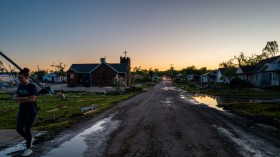By the year 2100 some places around the world can expect as many as 30 more days a year without precipitation, according to researchers from the University of California, San Diego's Scripps Institution of Oceanography.
The Scripps team reached their conclusion by running a computer climate simulation that projected future conditions. The models determined that regions including Central America, the Amazon, Indonesia and all Mediterranean climate regions around the world will likely see the greatest increase in the number of dry days. These regions are poised to go without precipitation for 30 days or more every year, the researchers said.
The study, led by Scripps post-doctoral researcher Sura Polade and colleagues, was published in the journal Scientific Reports. Scripps climate scientists Dan Cayan, David Pierce, Alexander Gershunov and Michael Dettinger, who are co-authors of the study.
"Looking at changes in the number of dry days per year is a new way of understanding how climate change will affect us that goes beyond just annual or seasonal mean precipitation changes, and allows us to better adapt to and mitigate the impacts of local hydrological changes," Polade said.
"Changes in intensity of precipitation events and duration of intervals between those events will have direct effects on vegetation and soil moisture," Stephen Jackson, director of the US Department of the Interior Southwest Climate Science Center, which co-funded the study, said in a statement.
"Polade and colleagues provide analyses that will be of considerable value to natural resource managers in climate adaptation and planning," Jackson said. "Their study represents an important milestone in improving ecological and hydrological forecasting under climate change."
The team used 28 climate models to run their analysis and draw conclusions about future precipitation levels. These models showed agreement across many parts of the world on the change of the number of dry days to be seen, but the models were not united in predicting the intensity of rain and snow when it does fall. However, there was consensus among the models that the most extreme precipitation will become more frequent.
"These profound and clearly projected changes make physical and statistical sense, but they are invisible when looking at long-term trends in average climate projections," study co-author Gershunov said.
The word's wettest regions are projected to get even wetter, according the the climate models. The researchers note that these regions are mostly not on land or are on uninhabited land.
In future studies, the researchers said they'd like to fine-tune their analysis to work toward understanding the innumerable regional factors that influence precipitation.
"Climate models have improved greatly in the last 10 years, which allows us to look in detail at the simulation of daily weather rather than just monthly averages," said study co-author Pierce.
© 2024 NatureWorldNews.com All rights reserved. Do not reproduce without permission.





